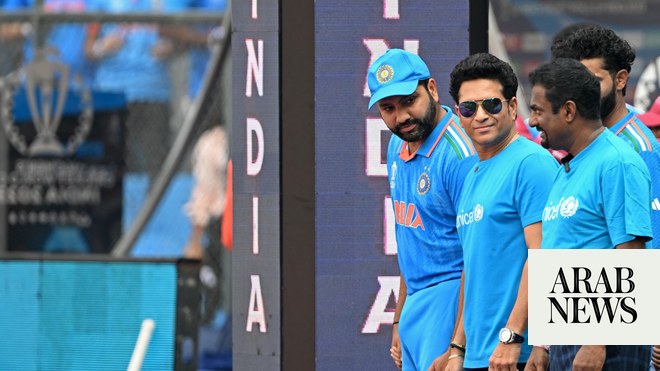
Against a background of outstanding achievements are cries for help by professional cricketers who want to reduce their workload
Fred Trueman of Yorkshire and England was long regarded as his nation’s greatest fast bowler. In his prime, he bowled a thousand overs for Yorkshire during a summer.
For the latest updates, follow us @ArabNewsSport
This was an era when the only cricket matches on view, apart from Tests, were three-day county championships between 17 counties. In 1964, Trueman was the first bowler to claim 300 wickets in Test matches. When asked if he thought his achievement would be beaten, his response — typical of the man — was: “Aye, but whoever does it will be very tired.”
Since then, 36 bowlers have beaten Trueman’s record. Sri Lanka’s Muttiah Muralitharan claimed 800, followed by Australia’s Shane Warne with 708, and then there is England’s James Anderson, who has 700 and is due to play his last Test this year.
Anderson’s longevity and fitness is truly remarkable. He has sent down almost 40,000 deliveries in Test matches alone, the fourth highest among those taking more than three hundred wickets. He is not admitting to any tiredness and is regarded by some as having claim to be England’s finest quick bowler, rather than Trueman. Both their achievements, in different eras, are extraordinary. Trueman’s feat was accompanied by a bowling average of 21.57, only bettered by Malcom Marshall (20.94) and Curtly Ambrose (20.99). Anderson’s is 26.52.
It is against the background of these achievements that current cries for help by professional cricketers to reduce their workload should be gauged. Another of Yorkshire’s finest players is Joe Root who, in 140 Tests for England so far, has scored 11,626 runs. This puts him 10th on the all-time list of top Test run scorers. His workload has been intense for years, even more so when he captained England in 64 Tests, yet he rarely complains. Last week, however, he called for a major rethink of English cricket’s crowded schedule.
This was accompanied by the Professional Cricketers Association calling for change “before something disastrous happens.”
Based on a survey of professional male cricketers, the PCA revealed that key concerns are physical heath (81 percent), travel conditions (75 percent) and mental health (62 percent). Long-distance driving late at night, whether moving between matches or traveling home, is a particular worry. It is argued that player welfare and performance are compromised by the lack of time to recover, prepare and practice.
Professional cricket in England and Wales has a particular issue in that there are four men’s competitions shoe-horned into a window between mid-April and the end of September, with August given over entirely to The Hundred. Last year, proposals to reduce the amount of four-day county cricket and T20 cricket were rejected by the counties. Effectively, the 50 over competition has been downgraded because so few of the top players appear in it. According to Root, the objective should be to get “the standard of first-class and county cricket as close as you can to the international game.”
Professional cricketers in England and Wales have raised the issue of congested schedules and travelling pressure before. The explosion of T20 cricket in the last 20 years has increased this congestion and turned it into a more international concern. In India and Australia, for example, the distances between venues are much greater, with flying and its attendant risks additional factors.
In November 2023, during the announcement of India’s ODI squad for a series against Australia, India’s captain, Rohit Sharma, blamed excessive travel for injured players across the teams. It is in the interests of all cricket boards to narrow the gap between the standard of the breeding ground of first-class cricket and international cricket. Each one has different ways of doing so, a reflection of relative resources, geography and historic structures.
In India, reform is proposed for 2024-25. It seems likely that the Ranji Trophy, the country’s state-based long format game and the equivalent of the English county championship, will be split into two halves. White ball tournaments would be held in between. The main drivers behind this are to address variable winter weather conditions in the north and to allow longer gaps between matches to facilitate travel and recovery. This is similar reasoning to that aired by Joe Root and the PCA.
More forgiving schedules may release pressure on mental health, an often-overlooked facet of professional sport. There have been a number of high-profile cases in recent years in cricket. Azeem Rafiq’s experience of racism at Yorkshire was one. Another was Jonathan Trott, who played 52 Tests for England between 2009 and 2015. He left England’s tour of Australia in November 2013, unable to cope with the demands at that level. A man with very high levels of concentration lost them and referred to the impact of social media, saying: “People don"t look you in the face and have a conversation and ask you how you are.”
Rohit Sharma, in the aftermath of India’s defeat in the 2023 ODI World Cup Final, was mentally shattered. He eschewed social media and opted out of ODI and T20I assignments against South Africa. Men’s cricket is a tough environment that appears not to appreciate that mental health issues are real. The growth of women’s cricket has brought about a change in approaches to mental health within the game. A webinar which I joined this week promoted by the Cricket Research Network discussed the different physiological challenges which women face in advancing in the game.
Quite what Fred Trueman would have made of this is an open question. He was an un-constituted menacing quick bowler who bullied opponents. It is not unreasonable to assume he would have been aghast at the notion of women playing professional cricket.
After his playing days were over, he became a pundit and commentator. His catch line was: “I don’t know what is going on.” He would be even more at a loss in today’s world of social media and Bollywood-style cricket.












